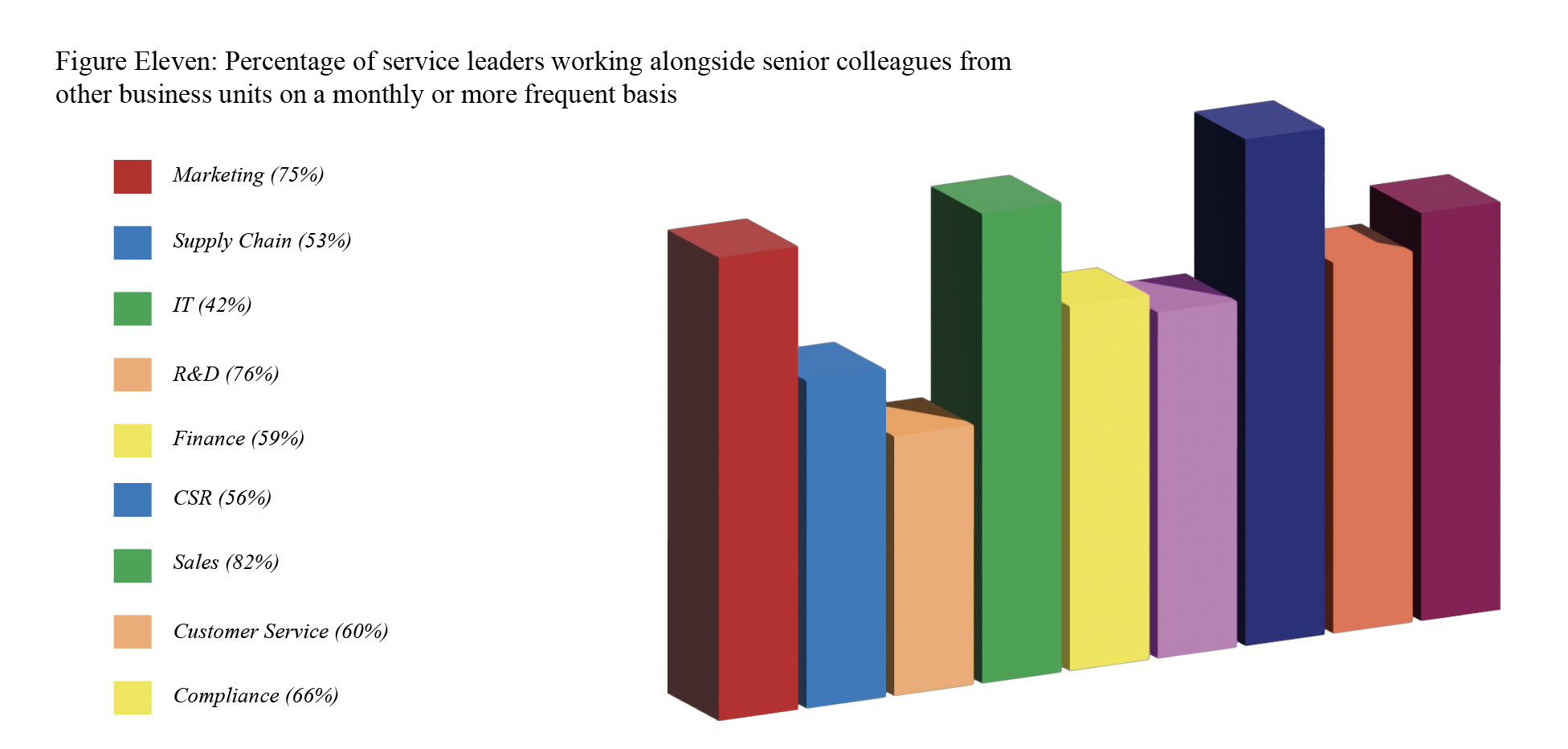The Perception of Field Service from Other Business Units
In this latest article in our series based on the latest Field Service News Research study hosted in partnership with ServiceMax, where we are exploring the correlations between asset data flow, servitization and cross-department collaboration, we explore how field service leaders believe their senior colleagues in other departments perceive the value of field service…
With this information in hand, the next thing we wanted to ascertain in the study was whether there was a correlation between the perceived understanding of the value of field service within other departments and the level of cooperation across departments.
We asked our respondents how often they work alongside leaders from other departments within the organization giving options of daily, weekly, monthly, quarterly, annually or never.
To begin, let us look at the percentages of companies that never work with other business units as there were some exciting findings amongst this set of conclusions.
For example, nearly a fifth (19%) of the field service leaders represented in the study had never worked alongside their colleagues in marketing; a similar amount of our respondents have never worked alongside their colleagues in compliance or R&D either (17% and 18% respectively). With each of these three disciplines potentially being likely to improve on their department KPIs if they had greater insight into field service operations, these findings certainly highlight just how frequently businesses still work within defined silos.
However, perhaps the perfect example of the lack of cohesion across departments is revealed when we see that almost a third of respondents (31%) have never worked alongside their colleagues in the Corporate Social Responsibility (CSR) division.
This finding in partuicular stands out as many of the fundamental elements of CSR should clearly be better aligned with more efficient field service operations.
There is an obvious argument for servitization based on a circular economy – something good for customers, the bottom line, and the environment. Similarly, the need to broaden recruitment paths ticks boxes when it comes to increasing the diversity of a workforce and overcoming the ageing workforce crisis many are facing.
The fact that CSR departments scored the second-lowest in terms of understanding the value of field service and lowest in terms of working alongside their field service management colleagues – suggests that there are many opportunities to drive improvements for both departments being overlooked because of a lack of understanding and collaboration.
At the other end of the spectrum, we see Customer Service and Sales showing a high correlation between the frequency these departments work with their colleagues in field service operations and their perceived understanding of the value field service brings to the broader organization.
Over 83% of respondents to the study stated they worked with leaders from Customer Services at least on a monthly basis. Almost a third (29%) of respondents stated they did so on a daily basis, and over two-thirds (35%) did so on a weekly basis. Nearly two thirds (60%) of respondents stated they felt their colleagues in Customer Service leadership understood the value of field service operations to the wider business. (Figure 11, below)

We saw a similar story with senior leadership within the Sales division.
Three quarters (75%) of the study respondents worked alongside their colleagues in senior leadership within the Sales unit on at least a monthly basis.
A quarter (25%) of respondents stated they did so on a daily basis, and just under half (44%) did so on a weekly basis. Perhaps unsurprisingly, Sales leadership was also cited as the department that understood the value of field service the most, with over three quarters (82%) of respondents stating they believed their colleagues in the Sales division had at least a good understanding of the value field service delivers to the wider organization.
Looking at these two business units, it would seem that there is a correlation between the frequency of collaboration and the perceived value of field service amongst business units within the organization.
However, the study findings reveal this is not always the case. Two other critical business units, IT and Finance, both show the inverse.
Over three quarters (77%) of respondents stated that they work with their senior colleagues from the IT department on at least a monthly basis. Almost a fifth (17%) of respondents declared they do so on a daily basis, while over two thirds (34%) do so on a weekly basis. Despite this frequent cross-department collaboration, the IT department was viewed as the least likely to have a good or better understanding of the value of field service to the wider business, with only 42% of respondents stating they felt this to be the case.
Regarding the Finance department, just under three quarters (73%) of respondents stated they work with their senior colleagues from this department at least once a month. However, less than a tenth said they do so on a daily basis, while almost half (47%) do so on a weekly basis.
However, once again, despite the relatively close working relationship between the field service and finance departments, only slightly more than half of the study respondents (57%) stated they felt their colleagues in senior leadership roles within the Finance department had an understanding of the value of field service that was good or better.
This would suggest that the correlation between the proximity and frequency of working relations with other units and a firm understanding of the value of field service operations in those respective divisions doesn’t necessarily hold.
With this in mind, we must consider how we move towards more effective collaboration that engenders a genuine understanding of the challenges within the respective business units.
We asked our respondents what they felt they would need for more effective collaboration between field service operations and other business units.
The most widely cited option provided was improved organizational structure, which almost two-thirds of respondents (61%) cited. This was closely followed by executive-level direction, which was cited by over half (53%) of respondents. In contrast, just under half of the respondents stated that greater data flow between business units would allow for more effective collaboration.
However, as we recall from earlier in this study, 81% of companies within the response set stated that they are currently sharing asset data across the wider business – with over half of respondents later saying that this would be a key area in which they could see improvements being made to facilitate better collaboration, the study findings would appear to indicate that while asset data may flow more freely than before, it is not being used effectively.
The answer to why this may be the case may be because there are multiple disparate IT systems within most organizations.
While slightly over a third (39%) of companies in the study state they are using a unified platform across all business units, a similar number (34%) state that they are using multiple solutions and data flow is limited.
Meanwhile, just under a fifth (18%) of companies state that they use multiple systems, and data flows seamlessly across these.
The study findings indicate that the resolution to better cross-department collaboration sits both in business structure and improves the flow of asset data between disparate systems. In one sense, it could be viewed that the organizational structure allows for collaboration to take place.
Still, a common view of data offers a shared language for all departments to have as a basis to make such collaborations effective.
Of course, both of these elements are often found at the heart of the discussion of servitization – and in the final feature in this series, we shall explore the correlation between servitization, asset data flow and cross-department collaboration.
Want to know more and can’t wait? Field Service News subscribers can access the full report on the button at the top of this feature.
This Field Service News Research study is sponsored by ServiceMax

 Data usage note: By accessing this content you consent to the contact details submitted when you registered as a subscriber to fieldservicenews.com to be shared with the listed sponsor of this premium content ServiceMax who may contact you for legitimate business reasons to discuss the content of this white paper.
Data usage note: By accessing this content you consent to the contact details submitted when you registered as a subscriber to fieldservicenews.com to be shared with the listed sponsor of this premium content ServiceMax who may contact you for legitimate business reasons to discuss the content of this white paper.


